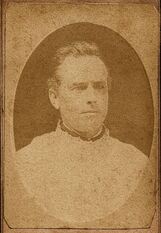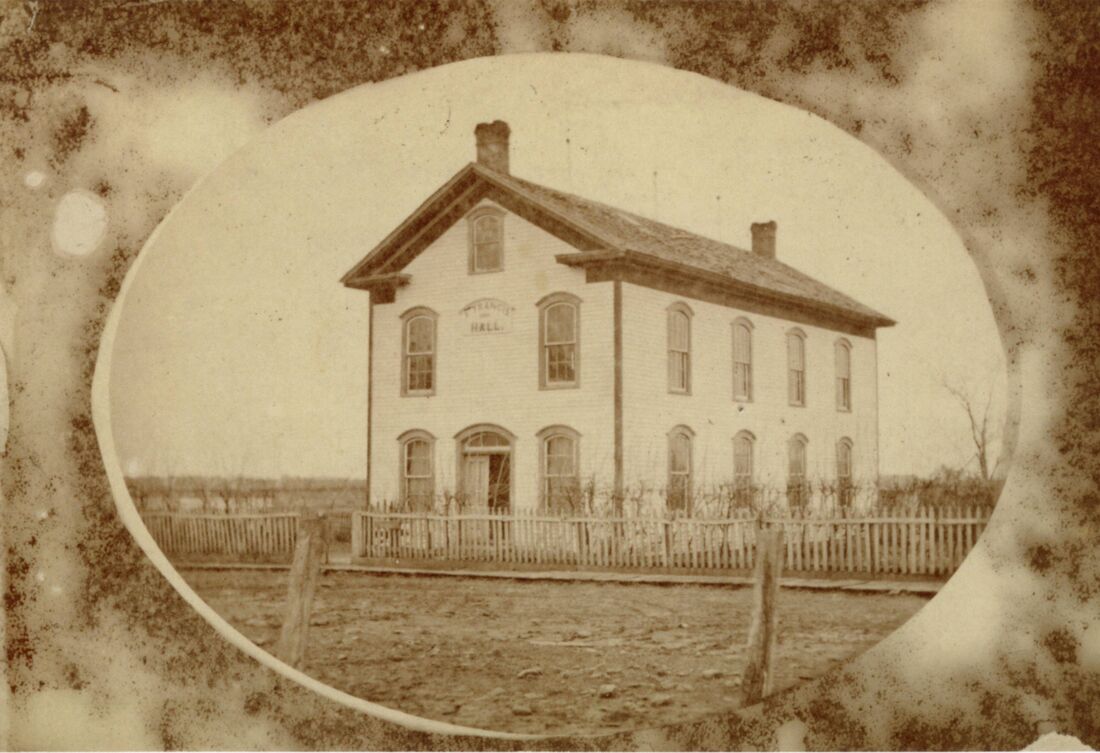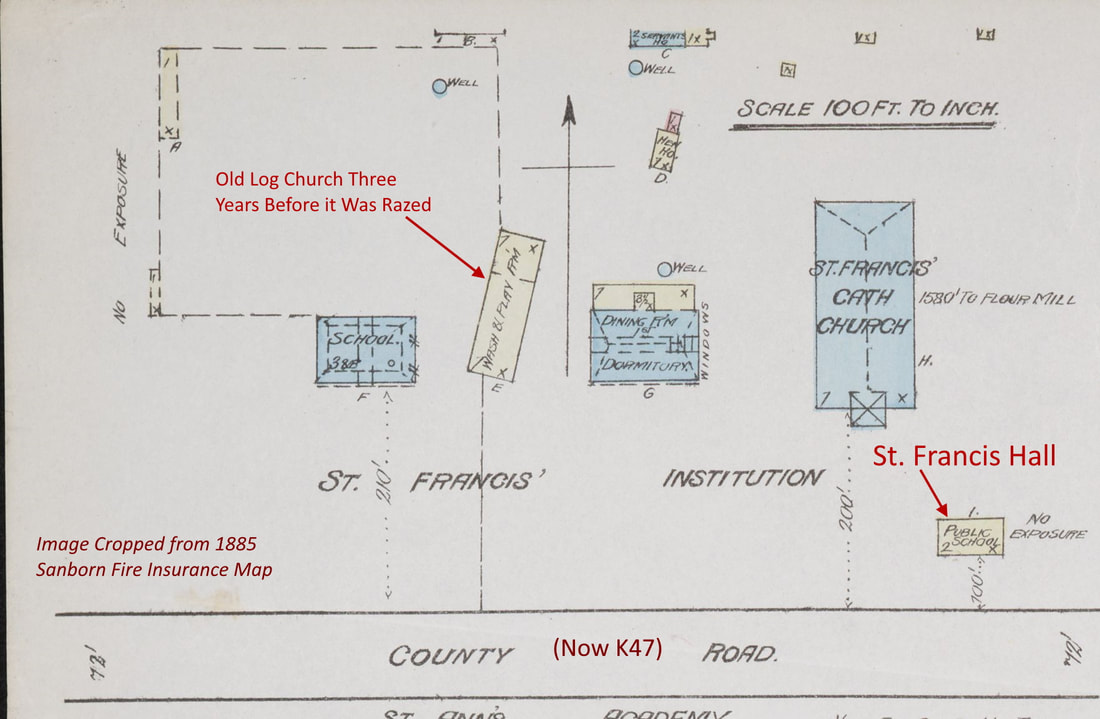|
As the Osages left Kansas for their Oklahoma reserve, the Jesuits and Sisters of Loretto had to shift gears rapidly. The Osage lands were opening for settlement; and the new town of Osage Mission was very attractive. It already had schools and trained educators. There was a Catholic Church, and a Methodist church on the way. But adequate school facilities were lacking. Some of the first white students, like Charlie Beechwood and Anna Duling, [1] were able to attend school in the original mission buildings, but new schools were needed.  Father Colleton [2] Father Colleton [2] A school building-boom started in 1869 that resulted in construction of a several buildings including public schools and two regional boarding colleges. During this time, Father Philip Colleton, one of the most well-known missionary trail riders, traded his saddle for pen, paper and his ingenuity. He assisted with design and construction of some of the new schools. But he clearly had more in mind than just new buildings. According to W.W. Graves [3] one of the new and important, buildings was the St. Francis Hall: "The first building of any importance, of frame construction, was erected in 1869. It was known for many years as St. Francis Hall. At first the lower story was used as a library and reading room for the public. The ladies of the parish, in 1869, organized a library society, and held a social in the Mission orchard to obtain funds. There were a number of Osages still living in the locality, and they attended this social along with the whites. The ladies raised $500 in one day with which to purchase books. With these books, they started, during the fall of 1869 what was probably the first free public library in the state of Kansas. Socials were held annually afterwards to increase the number of books. For fifty years this library continued to be used by the public. At present part of the books are still in use in the St. Francis school library near St. Paul. The building is now part of the Monastery barn." [4] St. Francis Hall was a multi-purpose building. In addition to the first-floor library, the second floor was a public assembly room and was also used, by the Sisters of Loretto as a school for the younger girls of the community. But the library fit well into Fr. Colleton's plans for his regional missionary work. In addition to stocking the Osage Mission library, he was able to raise money to purchase religious books and pamphlets that he distributed to Catholic families in southeast Kansas and southwest Missouri. Over time he was able to build several small churches, some of which were surrounded by new communities. This is how parishes in towns like Baxter Springs, Columbus, Scammon and Galena were formed. Using present landmarks, St. Francis Hall was built near the present St. Francis Catholic Church parking lot driveway (There was not a parking lot at the time.). As noted above, the building was later moved to the general area of Prairie Mission Retirement Village where it was used as a Passionist monastery barn. Some Reference Information.
1. For more information about Charlie Beechwood follow THIS LINK. This link also includes information about Anna Duling, and the iconic painting of the Osage Catholic Mission that is attributed to Beechwood's memory of the mission buildings. 2. For more information about Father Philip Colleton, follow THIS LINK. 3. W.W. Graves talks about Father Colleton's role in building St. Francis Hall, and the reference library in several of his books. Among these are:
4. In addition to the above, Sister Mary Paul Fitzgerald has a full chapter about Father Philip Colleton, including his work on St. Francis Hall, his library and missionary efforts in the four-state area in her book Beacon on the Plains, St. Mary College, 1939. Beacon on the Plains was her doctoral thesis. On page 160 of her book (footnote 26), she notes there was a previous library formed in Lawrence Kansas in the summer of 1859. It was started by seventeen-year-old Anna J. Prentiss. 5. Photos. The photo of St. Francis Hall and the 1885 Sanborn map were obtained from the Kansas State Historical Society. The photo of Fr. Philip Colleton was repaired from a newspaper photo that appeared in the Neosho County Journal (later the St. Paul Journal). |
Thoughts 'n ThingsSome 'Thoughts' and short articles about past and present-day St. Paul and the Southern Kansas - 4 State Region. Archives
December 2023
Categories
All
|
- Home
-
Our Story
- 1. The Stage is Set
- 2. The Osages Enter Kansas.
- 3. Earliest Commerce
- 4. Earliest Protestant Missions
- 5. The Catholic Osage Mission >
- 6. Progress and Tragedy
- 7. The Missionary Trails >
- 8. A Dangerous Balance - The Civil War >
- 9. The Osage Leave Kansas >
- 10. A Very Unique Community is Born >
- 11. Regional Boarding Schools >
- 12. Transitions
- 13. The Passionists Era Begins
- 14. Citizen Lawmen - The A.H.T.A. >
- 15. The Passionist Influence is Expanded
- 16. The Schools Today >
-
Characters
- The Osages
-
The Missionaries
>
- Father John Schoenmakers >
- Fr. John Bax >
- Mother Bridget Hayden
-
Fr. Paul Ponziglione
>
-
Father Paul's Memoir
>
-
Index - Father Paul's Memoir
>
- Dedication & Introduction
- IX. Construction & Acceptance of Mission Buildings.
- X. Fr. Schoenmakers Arrives at Osage Mission
- XI. Miss Lucille St. Pierre Came to the Neosho
- XII. Progress of the Schools
- XIII. Origin and Development of the Roman Catholic Church in Kansas
- XXVII - Winds of War
- XXVIII — Fr. Schoenmakers Return
- Chapter XLII - Farming Issues, Death Of Father Colleton
- Chapter XLIX - Includes The Death of Fr. Schoenmakers
- Chapter L — Dedication of the New Church
- Conclusion
- Appendix I — Copy of a letter to Sister M. Coaina Mongrain about the coming of the Sisters of Loretto at Osage Mission
- Appendix 6 — A Sketch of my Biography
- Appendix 7 - Letter to W. W. Graves
-
Index - Father Paul's Memoir
>
-
Father Paul's Memoir
>
- Father Philip Colleton
- Brother John Sheehan
- W. W. Graves
- 17 Sisters
- 17 Sisters II - Fr. Fox's Sermon
-
Who's Behind the Window
>
- Who We Were 120 Years Ago
- 1. The Thomas Carroll Window
- 2. The W.W. O'Bryan Window
- 3. The Jas. Owens & Family Window
- 4. The C.P & C.J. Hentzen Windows
- 5. The Dr. McNamara & Family Window
- 6. The Fitzsimmons & Family Window
- 7. The Parents of T.K. Joyce Window
- 8. J.E. Sevart & Family Window
- 9. The Rev. John Schoenmakers S.J. Window
- 10. The Patrick Diskin and L&M George Window
- 11. The J.A. Johnston & Family Window
- 12. The Peter & Jacob Bonifas Windows
- 13. The Mr & Mrs. Patrick Keeting Window
- 14. The John Butler Window
- 15. The Mr. & Mrs. Gutting Window
- 16. Rosette Window Above Doors
- 17. The Michael A. Barnes Window
- 18. The Henry M. O'Bryan Window
- 19. The John and Bridget McCarthy Window
- The Sodality Windows
- The Church Women's Bonfire (Graves)
- Beechwood
- John and Margaret Naudier
- Fr. Tom McKernan - The Poet Priest of Kansas
- The Dimond Family and Estate Sale
- Dear Sister >
- A Year and a Day — Passionist Memories.
- Mary Elizabeth Lease
- K of C Council 760 - The Early Days
- Our Hometown Boys
- SPHS Class of 1956
-
Places
- The Great American Desert
- St. Francis Catholic Church
- St. Francis de Heironymo Catholic Church Grounds
- St. Paul - 135 Years Ago
- St. Paul - 1890's as a Scale Model.
- St. Paul - The Booming 60's
- Osage Mission as a Statewide History Finalist
- St. Francis Cemetery
- Hope Cemetery
- The Basement Chapel
- World War I Museum Display
- St. Paul Middle School >
- Ladore
- St. Boniface, Scipio KS
- Road Trip - Father Emil Kapaun
- Exchange State Bank Robbery!
- Thoughts ...
- Links
- Link Page
Thoughts 'n Things
Past and Present Day St. Paul, Southern Kansas and The Four - State Region.

|
acatholicmission.org is a privately hosted website. We hope that our site will educate and entertain those who are interested in the fascinating Osage Mission - St. Paul - Neosho County Kansas story. Ours is a regional story that crosses state lines, ethnic groups, faiths and a variety of frontier and post-frontier interests. Enjoy.
acatholicmission.org Copyright © 2016 - 2024. All rights reserved. (See copyright note on Contact page.) |


 RSS Feed
RSS Feed